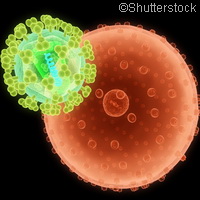The protein that starves HIV
An international team of researchers has discovered that a protein responsible for protecting some of our body's immune cells from the most common and virulent form of HIV succeeds in its quest because it starves the virus of the molecular building blocks it requires to replicate. The study, published in the journal Nature Immunology, was supported in part by a European Research Council (ERC) grant under the EU's Seventh Framework Programme (FP7). The results could help us understand why some anti-HIV drugs are more effective than others. Researchers led by the Institut National de la Santé et de la Recherche Médicale (INSERM) in France say this latest development could prove beneficial, not just for the development of anti-HIV drugs but also for the potential impact on other pathogens including herpes viruses. 'The findings may explain why certain anti-HIV drugs used today are more effective under some circumstances and not others,' says Professor Baek Kim of the University of Rochester Medical Center in the United States, one of the authors of the paper. 'It also provides new insights on how many other viruses that afflict people operate in the body.' The research focuses on the protein known as SAMHD1, found in white blood cells that experts call macrophages as well as related cells known as dendritic cells. In 2011, researchers found that the molecule hampers the ability of HIV-1 to infect macrophages, which are responsible for 'consuming' pathogens including viruses. In this latest study, the team discovered that the SAMHD1 molecule cuts off the supply line of raw materials that HIV requires for deoxyribonucleic acid (DNA) creation and replication, deoxynucleoside triphosphates (dNTPs), the building blocks of DNA. SAMHD1 damages these building blocks, effectively thwarting HIV-1's ability to replicate inside macrophages. The study also sheds light on how a protein expressed by the other common type of HIV, HIV-2, blocks SAMHD1. The viral protein X (Vpx) degraded SAMHD1 protein, thus facilitating HIV-2 infection of macrophages. 'We don't know precisely how SAMHD1 and Vpx affect the virulence of HIV-1 and HIV-2, but it's something we're actively exploring,' Dr Kim explains. 'In this case, the ability of HIV-2 to replicate more quickly in macrophages does not help it become more virulent.' The team hypothesises that mutations in viral DNA circumvent the pathway blocked by SAMHD1. Therein lies the biggest difficulty in treating patients. 'It makes sense that a mechanism like this is active in macrophages,' Dr Kim says. 'Macrophages literally eat up dangerous organisms, and you don't want those organisms to have available the cellular machinery needed to replicate. And macrophages themselves don't need it, because they don't replicate. So macrophages have SAMHD1 to get rid of the raw material those organisms need to copy themselves. It's a great host defence. The work suggests new ways to target virus replication in macrophages, a critically important cell population that serves as a key reservoir of virus infection and a contributor to HIV-induced disease.'For more information, please visit: INSERM: http://www.inserm.fr/ Nature Immunology: http://www.nature.com/ni/index.html
Countries
France, United States



